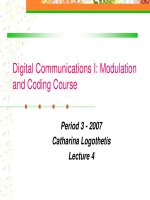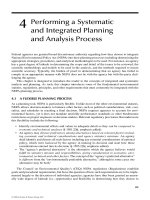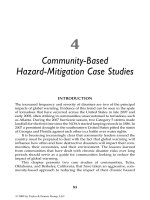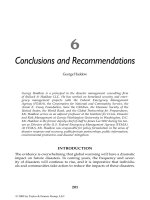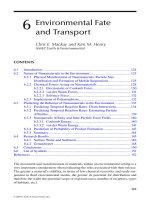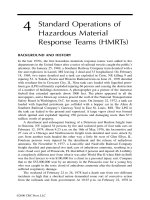BIOGEOCHEMICAL, HEALTH, AND ECOTOXICOLOGICAL PERSPECTIVES ON GOLD AND GOLD MINING - CHAPTER 4 pdf
Bạn đang xem bản rút gọn của tài liệu. Xem và tải ngay bản đầy đủ của tài liệu tại đây (264.66 KB, 11 trang )
39
CHAPTER
4
Properties
Gold is a complex and surprisingly reactive element, with unique physical,
chemical, and biochemical properties. Some of these properties are listed and dis-
cussed below.
4.1 PHYSICAL PROPERTIES
Gold is a comparatively rare native metallic element, ranking fiftieth in abun-
dance in the earth’s crust. The chemical symbol for gold is Au, from the Latin
aurum
for gold. Metallic gold is an exceptionally stable form of the element and most
deposits occur in this form. The main elements with which gold is admixed in nature
include silver, tellurium, copper, nickel, iron, bismuth, mercury, palladium, platinum,
indium, osmium, iridium, ruthenium, and rhodium. The native gold–silver alloys
have a color range from pale yellow to pure white, depending on the amount of
silver present. Finely divided gold is black, like most other metallic powders, while
colloidally suspended gold varies in color from deep ruby red to purple. Gold occurs
as metallic gold (Au
0
) and also as Au
+
and Au
+3
, so that it occurs in combination
with tellurium as calaverite (AuTe
2
) and sylvanite (AuAgTe
4
), and also with tellu-
rium, lead, antimony, and sulfur as nagyagite, Pb
5
Au(Te,Sb)
4
S
5-8
(Rose 1948; Ran-
som 1975; Sadler 1976; Puddephatt 1978; Krause 1996).
Gold is characterized by an atomic weight of 196.967, atomic number of 79, a
melting point of 1063
°
C, and a boiling point of about 2700
°
C. In the massive form,
gold is a soft yellow metal with the highest malleability and ductility of any element.
A single troy ounce of gold can be drawn into a wire over 66 km in length without
breaking, or beaten to a film covering approximately 100 m
2
. Traces of other metals
interfere with gold’s malleability and ductility, especially lead, but also cadmium,
tin, bismuth, antimony, arsenic, tellurium, and zinc. It is extremely dense, being
19.32 times heavier than water at 20
°
C. A cube of gold 30 cm (12 in.) on a side
weighs about 544 kg (1197 lb). Gold has high thermal and electrical conductivity,
properties that make it useful in electronics. It is extremely resistant to the effects
2898_book.fm Page 39 Monday, July 26, 2004 12:14 PM
40 PERSPECTIVES ON GOLD AND GOLD MINING
of oxygen and will not corrode, tarnish, or rust. Pure (100%) gold is 1.000 fine,
equivalent to 24 carats. Gold is usually measured in troy ounces, wherein 1 troy
ounce equals 31.1 g vs. 28.37 g in an ounce avoirdupois (Rose 1948; Ransom 1975;
Sadler 1976; Puddephatt 1978; Elevatorski 1981; Gasparrini 1993; Cvancara 1995;
Krause 1996; Petralia 1996; Merchant 1998).
Gold has 30 known isotopes, but only one,
197
Au, is stable. The nucleus of
197
Au
contains 79 protons and 118 neutrons. Isotopes of mass numbers 177 to 183 are all
α
emitters and all have a physical half-life of <1 min. Isotopes of mass numbers
185 to 196 decay by electron capture accompanied by radiation and in some cases
by positron emission. The only long-lived isotope is
195
Au with a half life of 183 days.
The neutron-heavy isotopes of 198 to 204 all decay by emission accompanied by
radiation. The isotope
198
Au is widely used in radiotherapy, in medical diagnosis,
and for tracer studies (Puddephatt 1978; Windholz 1983).
The color of gold alloys depends on the metal mixture. Red gold is comprised
of 95.41% Au and 4.59% copper (Cu); yellow gold of 80% gold and 20% silver
(Ag); and white gold of 50% Au and 50% Ag. The white gold commonly used in
jewelry contains 75 to 85% Au, 8 to 10% nickel, and 2 to 9% zinc, while more
expensive white alloys include palladium (90% Au to 10% Pd) and platinum (60%
Au, 40% Pt). Colloidally suspended gold varies in color from deep ruby red to
purple, and is used in the manufacture of ruby glass. Gold–silver–copper alloys are
frequently used in coinage and gold wares. A purple alloy results with 80% Au and
20% aluminum, but this compound is too brittle to be made into jewelry. Gold forms
alloys with many other metals, but most of these are also brittle. As little as 0.02%
of tellurium, bismuth, or lead makes gold brittle (Rose 1948; Ransom 1975;
Puddephatt 1978).
Analytical methodologies to measure gold in biological samples and abiotic
materials rely heavily on its physical properties. These methodologies include x-ray
fluorescence (Borjesson et al. 1993; Messerschmidt et al. 2000), adsorptive stripping
voltammetry (Lack et al. 1999), bacteria-modified carbon paste electrodes (Hu et al.
1999), inductively-coupled plasma mass spectrometry [ICP-MS] (Higashiura et al.
1995; Perry et al. 1995; Barefoot and Van Loon 1996; Christodoulou et al. 1996;
Barefoot 1998; Barbante et al. 1999), atomic absorption spectrometry [AAS] (Brown
and Smith 1980; Kehoe et al. 1988; Niskavaara and Kontas 1990; Ohta et al. 1995;
Begerow et al. 1997), fire assay (Gasparrini 1993), and neutron activation [NA] and
spectrometry (Shiskina et al. 1990). Analyses of gold based upon gravimetric,
volumetric, and UV/visible spectrophotometric techniques have been largely dis-
placed by instrumental methods, such as NA, AAS, and more recently ICP-MS and
ICP-AAS. In ICP-MS, for example, detection limits of gold after preconcentration
of samples were as low as 0.04 ng/g ash in vegetation, 0.1 to 0.8 ng/L in water and
urine, and 0.1 ng/g in soils and sediments (Perry et al. 1995; Barefoot and Van Loon
1996; Barefoot 1998). It is noteworthy that the fire assay method to analyze ore
samples for gold content is the most convenient and least expensive method used
throughout the world, despite interferences from copper, nickel, lead, bismuth, and
especially tellurium and selenium (Gasparrini 1993). The fire assay, known to met-
alworkers for at least 3000 years, involves a weighed sample of the pulverized rock
2898_book.fm Page 40 Monday, July 26, 2004 12:14 PM
PROPERTIES 41
melted at 1000
°
C in a flux containing lead oxide, a measured amount of silver, soda,
borax, silica, and potassium nitrate (Kirkemo et al. 2001). The lead fraction contains
the gold and added silver and settles to cool as a button, which is subsequently
remelted, oxidized to remove the lead oxide, leaving behind a bead consisting of
precious metals. The bead is dissolved in acid and usually analyzed by AAS.
4.2 CHEMICAL PROPERTIES
The chemistry of gold is complex. Gold can exist in seven oxidation states: –1,
0, +1, +2, +3, +4, and +5. Apart from Au
0
in the colloidal and elemental forms, only
Au
+
and Au
+3
are known to form compounds that are stable in aqueous media and
important in medical applications (Table 4.1; Puddephatt 1978; Shaw 1999a, 1999b).
The remaining oxidation states of -1, +2, +4, and +5 are not presently known to
play a role in biochemical processes related to therapeutic uses of gold (Shaw 1999b).
Neither Au
+
or Au
+3
forms a stable aquated ion ([Au(OH
2
)
2-4
+
] or [Au(OH
2
)
4
3+
],
respectively) analogous to those found for many transition metal and main group
cations. Both are thermodynamically unstable with respect to elemental gold and
can be readily reduced. The gold-based anti-arthritic agents are considered pro-drugs
that undergo rapid metabolism to form new metabolites (Shaw 1999a), a phenom-
enon that will be discussed in detail later. In complexes containing a single gold
atom, the oxidation states +1, +2, +3, and +5 are well established (Puddephatt 1978).
Divalent gold (Au
+2
) is rare, usually being formed as a transient intermediate in
redox reactions between the stable oxidation states Au
+
and Au
+3
. The first Au
+5
complex containing the ion AuF
6
–
was reported in 1972. The compound AuF
5
can
also be prepared. Both are powerful oxidizing agents. Gold also forms many com-
plexes with metal–metal bonds in which it is difficult to assign formal oxidation
states. Additional information on stereochemistry, stability of complexes, oxidation–
reduction potentials, current theories, and other aspects of gold chemistry is pre-
sented in detail by Sadler (1976), Puddephatt (1978), Merchant (1998), and Schmid-
baur (1999).
Table 4.1 Oxidation States of Gold, Examples,
and Stability in Water
Oxidation
State Example Stable
–1 CsAu, ammoniacal Au
–
No
0 Metallic and colloidal gold Yes
+1 Au(CN)
2
–
, aurothiomalate Yes
+2 Au
2
(CH
2
PMe
2
CH
2
)
2
Cl
2
No
+3 AuCl
4
–
, Au(CN)
–
Ye s
+4 Au(S
2
C
6
H
4
)
2
No
+5 AuF
6
–
No
Source:
Data from Puddephatt 1978; Shaw 1999a,
1999b.
2898_book.fm Page 41 Monday, July 26, 2004 12:14 PM
42 PERSPECTIVES ON GOLD AND GOLD MINING
Metallic gold (Au
0
) is comparatively inert chemically. Gold is resistant to
tarnishing and corrosion during lengthy underground storage or immersion in sea-
water. It does not oxidize or burn in air even when heated. However, gold reacts
with tellurium at high temperatures to yield AuTe
2
and reacts with all the halogens.
Bromine is the most reactive halogen and, at room temperatures, reacts with gold
powder to produce Au
2
Br
6
. At temperatures below 130
°
C, chlorine is adsorbed onto
the gold, forming surface compounds; at 130 to 200
°
C, further reactions occur but
the rate is limited by the diffusion rate of chlorine through the surface layer of gold
chlorides; at >200
°
C, a high reaction rate occurs as the gold chlorides sublime,
continually exposing a gold surface. Atomic gold is considerably more reactive than
the massive metal (Puddephatt 1978). Evaporation of gold at high temperatures under
vacuum followed by cocondensation of the vapor with a suitable reagent onto an
inert noble-gas matrix at liquid helium temperature produces Au(O
2
), Au(C
2
H
4
),
Au(CO), and Au(CO
2
). Cocondensation of atomic gold with carbon monoxide and
dioxygen gives the complex Au(CO)
2
O
2
; all of these gold compounds decompose
on warming the matrix (Puddephatt 1978). When auric oxide is treated with strong
ammonia, a black powder is formed called fulminating gold (AuN
2
H
3
, 3H
2
O). Dried,
it is a powerful explosive as it detonates by either friction or on heating to about
145
°
C. Caution is advised when handling this compound (Rose 1948).
Halogen compounds of gold are well known, especially aurous chloride (AuCl)
and auric chloride (AuCl
3
; Rose 1948). Aurous chloride is a yellowish-white solid
that is insoluble in cold water, but it undergoes slow decomposition into Au
0
and
AuCl
3
. Auric chloride takes the form of a reddish brown powder or ruby red crystals.
The auric chloride of commerce is aurichloric or chloroauric acid (HAuCl
4
·3H
2
O),
a brown deliquescent substance that is soluble in water or ether. Aurichloric acid
forms a series of salts called aurichlorides or chloroaurates. Aurichlorides of Li, K,
and Na are very soluble in water, and those of Rb and Cs much less soluble. The
sodium salt, NaAuCl
4
·2H
2
O, is sold as sodio-gold chloride and, unlike aurichloric
acid, is not deliquescent. Two gold bromides are known, AuBr and AuBr
3
, corre-
sponding to their chlorine counterparts. Auric iodide (AuI
3
) is unstable and decom-
poses into aurous iodide (AuI) and free iodine. Iodine in aqueous-alcoholic solutions
combines with metallic gold to form aurous iodide, a white or lemon-yellow powder
that is insoluble in water (Rose 1948).
Gold is inert to strong alkalis and virtually all acids, except aqua regia — a
mixture of concentrated nitric acid (1 part) and hydrochloric acid (3 parts). The
nitric and hydrochloric acids interact forming nitrosylchloride (NOCl) together with
free chlorine, which reacts with gold. In aqua regia, gold forms tetrachloroauric
acid, HAuCl
4
, which is the source of gold chloride. Gold is also soluble in hot selenic
acid forming gold selenate, and in aqueous solutions of alkaline sulfides and thio-
sulfates (Rose 1948; Krause 1996; Merchant 1998). Gold will dissolve in hydro-
chloric acid in the presence of hypochlorite or ferric iron (Fe
+3
) as oxidant. The
dissolution of gold in cyanide solutions with air or hydrogen peroxide as oxidant is
another example of this effect (Ransom 1975; Puddephatt 1978). The reaction with
oxygen as oxidizing agent apparently takes place by adsorption of oxygen onto the
gold surface, followed by reaction of this surface layer to yield AuCN, followed by
the complex Au(CN)
2
–
, which passes into solution (Rose 1948; Puddephatt 1978).
2898_book.fm Page 42 Monday, July 26, 2004 12:14 PM
PROPERTIES 43
Gold is also soluble in liquid mercury and in dilute solutions of sodium or calcium
cyanide. The cyanide solvent was used in Australia in 1897 where it was used to
remove finely disseminated gold from pulverized rock. The cyanide process is the
only known method of profitably treating massive low-grade gold ores. Using the
cyanide process, auriferous rocks containing as little as 1 part gold in 300,000 parts
of worthless materials can be treated successfully (Ransom 1975; Cvancara 1995).
Gold is readily dissolved by halide or sulfide ions in the presence of oxidizing
agents to yield Au
+3
or Au
+
complexes (Puddephatt 1978). It is probably in this way
that gold is dissolved when hot volcanic rock is buried, or when a hot granite
intrusion rises near the surface of the earth’s crust. As the solution cools to 300 to
400
°
C, concentrations of oxygen and hydrochloric acid decrease sharply, and gold
is redeposited. Hydrothermal transfer of gold as the complex ion [Au(SH)
2
]
–
may
occur in some cases. Dissolution and redeposition of gold in stream beds may also
be responsible for the formation of large crystals of alluvial gold (Puddephatt 1978).
Solutions containing gold complexes, such as AuCl
4
–
, are easily reduced to Au
0
and under controlled conditions colloidal gold may be formed. Colloids of gold —
first reported in the 18th century — may be red, blue, or violet depending on the
mean particle size and shape (Puddephatt 1978). Various reducing agents can be
used for preparing colloidal gold including tannin, phosphorus, formaldehyde, and
hydrazine hydrate. The “purple of Cassius” is a mixed colloid of hydrated Sn
+4
oxide
and gold formed by reducing AuCl
4
–
with Sn
+2
chloride, A purple or ruby-red
precipitate is formed on heating the solution. A sensitive test for gold is based on
this process, that is, a purple color is formed if a 10
–8
M
solution of AuCl
4
–
is added
to a saturated solution of SnCl
2
(Puddephatt 1978).
The chlorination process, introduced in 1867, remains one of the most important
refining processes for raw gold (Dahne 1999). Chlorination makes use of the fact
that silver, copper, and base metals in raw gold react with chlorine at about 1100
°
C
to form stable chlorides while gold and platinum chlorides are unstable at >400
°
C.
At 1100
°
C, silver chloride and copper chloride are molten, and base metal chlorides
are volatile. The silver and copper chlorides are removed by skimming. Chlorination —
which is usually completed within a few hours — is usually stopped at 99% gold so
that gold losses by vaporization are avoided. Other refining processes for gold include
electrolysis, and wet-chemical separation of gold from silver and base metals. In
electrolysis, the anode plates are a mixture of tetrachloroauric acid, hydrochloric
acid, and raw gold, and the cathodes are thin titanium (Dahne 1999).
4.3 BIOCHEMICAL PROPERTIES
Gold is not an essential element for living systems (Brown and Smith 1980).
Indeed, the administration of gold to patients has been more similar to that of toxic
elements, such as mercury, than to that of biologically utilized transition elements
such as copper and iron. Gold distributes widely in the body and the number of
possible reactions and reaction sites is large. Most of the
in vivo
gold chemistry is
concerned with the reaction of gold species with thiols. Within mammalian systems
subjected to Au
0
, Au
+
, or Au
+3
, gold metabolism resulted in both monomeric and
2898_book.fm Page 43 Monday, July 26, 2004 12:14 PM
44 PERSPECTIVES ON GOLD AND GOLD MINING
polymeric species. Most gold complexes administered orally or parenterally were
absorbed, but rate and extent of accumulation were highly variable among gold
compounds. Gold circulated in blood mainly by way of the serum proteins, especially
albumin. Gold was deposited in many tissues and was dependent on dose and
compound administered. Likely storage forms included colloidal Au
0
, insoluble Au
+
deposits, and possibly Au
+3
polymers. Accumulated gold containing sulfur was
documented. There is no suitable animal model available for testing mechanisms of
action of gold compounds used in human medicine (Brown and Smith 1980).
Gold has a unique biochemical behavior (Sadler 1976). Biochemical behaviors
of heavy metal ions show some similarities, particularly in their affinity for polar-
izable ligands. But they also show important differences. Gold, for example, has a
comparatively low affinity for amino and carboxylate groups, a stable higher oxi-
dation state in water, and proven anti-inflammatory activity of selected Au
+
organic
salts (Sadler 1976). The biochemistry of gold has developed mainly in response to
prolonged use of gold compounds in treating rheumatoid arthritis and in response
to efforts to develop complexes with anti-tumor and anti-HIV activity (Shaw 1999b).
Chemical reactions of gold drugs exposed to body fluids and proteins are mainly
ligand exchange reactions that preserve the Au
+
oxidation state (Shaw 1999a).
Aurosomes (lysosomes that accumulate large amounts of gold and undergo mor-
phological changes) taken from gold-treated rats contain mainly Au
+
, even when
Au
+3
has been administered. However, the potential for oxidizing Au
+
to Au
+3
in vivo
exists. Monovalent gold drugs can be activated
in vivo
to an Au
+3
metabolite that is
responsible for some of the immunological side effects observed in chrysotherapy.
For example, treatment of rodents and humans with anti-arthritic monovalent gold
drugs generates T-cells that react to Au
+3
but not to the parent compound (Shaw
1999a).
Although metallic gold (Au
0
) is arguably the least corrosive and most biologically
inert of all metals, it can be gradually dissolved by thiol-containing molecules such
as cysteine, penicillamine, and glutathione to yield Au
+
complexes (Merchant 1998).
Metallic gold reacted with cysteine in aqueous or saline solution in the presence of
oxygen to produce an Au
+
–cysteine complex; Au
+
and cysteine formed a 1:1 Au
+
–
cysteine complex; L-cysteine reduced most Au
+3
compounds in solution to produce
the Au
+
–L-cysteine complex (Brown and Smith 1980). With D-penicillamine, Au
0
formed a Au
0
–penicillamine complex; Au
+
under a nitrogen environment formed a
R
3
PAu
+
–penicillamine complex; and Au
+3
formed a bis complex with penicillamine.
With glutathione, Au
+
formed a stable 1:1 complex in solution; Au
+3
oxidized
glutathione to sulfoxide, the gold being reduced to Au
+
, which was stabilized by
complexing with unreacted glutathione (Brown and Smith 1980). These processes
were amplified at alkaline pH, significantly at pH 7.2, and perceptibly in acidic
environments having pH values as low as 1.2 (Merchant 1998). The rate of the
reaction was controlled by the concentrations of thiol-containing molecules and by
the pH; reactions might take place within cells and inside lysosomes. Under favorable
conditions, reactions occurred at low rates on skin surfaces. Skin samples taken from
beneath gold wedding bands of normal individuals averaged 0.8 mg/kg dry weight
skin.
In vitro
studies designed to simulate conditions inside phagocytic lysosomes
2898_book.fm Page 44 Monday, July 26, 2004 12:14 PM
[See Chapter 9 for additional details.]
PROPERTIES 45
showed substantial dissolution of Au
0
in the presence of hydrogen peroxide and
amino acids such as histidine and glycine. There are reported instances of rheumatoid
arthritis patients who, on initiation of gold drug treatment (chrysotherapy), have
promptly produced rashes in the skin areas that have had regular contact with gold
jewelry. Gold jewelry, if in close contact with skin, could be slowly dissolved by
sweat. Thus, the thinning of gold rings over time, thought to be due mainly to abrasion,
could also be due, in part, to dissolution (Merchant 1998).
Colloidal gold is readily accumulated by macrophages (Sadler 1976). The gold
particles are taken into small vesicles, which form by surface invagination, and into
vesicles fusing to form vacuoles with subsequent transport to the centrosomic region.
The part played by the surface of the Au
0
particle may be due to Au
+
ions on the
surface, which promote uptake. A soluble gold-uptake stimulating factor of MW
<100,000 is reportedly secreted by lymphocytes and acts upon the macrophages
(Sadler 1976).
Gold
+
drugs were metabolized rapidly in vivo (Shaw 1999a). The half life for
gold excretion in dogs was 20 days, but major metabolites had half-life times of 8
to 16 hours. Within 20 minutes of administration, gold was protein-bound mainly
in the serum. Injectable gold
+
drugs were not readily taken up by most cells, but
bound to cell surface thiols where they affected cell metabolism. The high affinity
of Au
+
for sulfur and selenium ligands suggested that proteins, including enzymes
and transport proteins, were critical in vivo targets. It was clear that extracellular
gold in the blood was primarily protein bound, suggesting protein-mediated transport
of gold during therapy (Shaw 1999a). Metallothioneins play an important role in
metal homeostasis and in protection against metal poisoning in animals (Eisler 2000).
Metallothioneins are cysteine-rich (>20%), low-molecular-weight proteins with a
comparatively high affinity for gold, copper, silver, zinc, cadmium, and mercury.
These heat-stable metal-binding proteins were found in all vertebrate tissues and
were readily induced by a variety of agents — including gold — to which they bind
through thiolate linkages. The role of metallothioneins in maintaining low intracel-
lular gold concentrations needs to be resolved.
Following a chrysotherapy-type regimen with gold disodium thiomalate in mice,
Au
+3
generation was analyzed with a lymph node assay system using T-lymphocytes
sensitized to Au
+3
(Merchant 1998). The findings were consistent with three separate
anti-inflammatory mechanisms:
1. Generation of Au
+3
from Au
+
scavenges reactive oxygen species, such as hypochlo-
ric acid.
2. Au
+3
is a highly reactive chemical that irreversibly denatures proteins, including
those lysosomal enzymes that nonspecifically enhance inflammation when they
are released from cells at an inflammatory focus.
3. Au
+3
may interfere with lysosomal enzymes involved in antigen processing or
may directly alter molecules along the lysosomal–endosomal pathway, resulting
in reduced production of arthritogenic peptides (Merchant 1998).
If all of these activities occurred within a redox system in phagocytic cells, then
the anti-inflammatory actions of Au
+
/Au
+3
could be effective for protracted periods,
and explain, in part, both the anti-inflammatory and the adverse effects of antirheumatic
2898_book.fm Page 45 Monday, July 26, 2004 12:14 PM
46 PERSPECTIVES ON GOLD AND GOLD MINING
Au
+
drugs. Deviation of proteins could also contribute to the rare instances of auto-
immunity reported in association with chrysotherapy (Merchant 1998).
Knowledge of Au
+
binding sites on large molecules, such as proteins, is limited to
a few studies using Au(CN)
2
–
(Sadler 1976). Although Au(CN)
2
–
is one of the most
stable gold ions in solution, it is considered too toxic for clinical use. The simple Au
+
cation does not appear to exist in solution, and most Au
+
compounds are insoluble
or unstable in water. Mercaptides stabilize Au
+
in water, and sodium gold thiomalate
is now in widespread use as an anti-inflammatory drug. Ionic Au
+
seems to enter many
cells but localize within the lysosomes of the phagocytic cells called macrophages.
Here they may inhibit enzymes important in inflammation. Studies with sodium gold
thiomalate suggest that anti-tumor mechanisms, like inflammation, are also macro-
phage-mediated (Sadler 1976).
Canumalla et al. (2001) report on two recent advances in understanding gold
metabolism in vivo. In one finding, gold
+
drugs and their metabolites react in vivo
with cyanide, forming dicyanoaurate
+
, (Au
+
(CN)
2
)
–
; this ion has been identified as
a common metabolite of Au
+
drugs in blood and urine of chrysotherapy patients.
Second, Au
+
is the primary oxidation state found in vivo although there is increasing
evidence for the generation of Au
+3
metabolites. Biomimetic studies indicate that
the oxidation of sodium gold
+
thiomalate and sodium gold
+
thioglucose by hypochlo-
rite ion (OCl)
–
, released when cells are induced to undergo the oxidative burst at
inflamed sites, is rapid and thermodynamically feasible in the formation of Au
+3
species. The OCl
–
ion is involved in both the generation of Au(CN)
2
–
and the
formation of Au
+3
species in vivo (Canumalla et al. 2001).
The potential anti-tumor activity of gold complexes is driven by three rationales:
(1) analogy to immunomodulatory properties underlying the benefit from Au
+
com-
plexes in treating rheumatoid arthritis; (2) the structural analogy of square-planar
Au
+3
to platinum
+2
complexes, which are potent anti-tumor agents; and (3) complex-
ation of Au
+
or Au
+3
with other active anti-tumor agents in order to enhance the
activity and alter the biological distribution of Au
+3
(Shaw 1999a). For example,
the rate of hydrolysis of AuCl
4
–
in water is 375 times greater than that of PtCl
4
–
(Sadler 1976). There is potential for developing new cytotoxic gold complexes that
have anti-tumor properties, and this requires robust, new ligand structures that can
move gold through cell membranes and into the cytoplasm, and perhaps into the
cell nucleus (Shaw 1999a). Trivalent gold (Au
+3
) compounds are potential anticancer
agents (Calamai et al. 1997). These compounds are soluble in organic solvents, such
as methanol or DMSO, but poorly soluble in water. In water, AuCl
3
undergoes
hydrolysis of the bound chloride without loss of the heterocycle ligand. When Au
+3
compounds react with proteins, like albumin or transferrin, Au
+3
is easily reduced
to Au
+
. Cytotoxicity studies with tumorous cells showed marked anticancer activity
of Au
+3
complexes, probably mediated by a direct interaction with DNA. However,
rapid hydrolysis of Au
+3
to Au
+
under physiological conditions may severely restrict
their use. More studies are needed to understand the biological mechanisms of gold
complexes, including extent of cell penetration and biodistribution (Calamai et al.
1997).
2898_book.fm Page 46 Monday, July 26, 2004 12:14 PM
PROPERTIES 47
Anti-HIV activity of monovalent gold compounds were associated with inhibi-
tion of reverse transcriptase (RT), an enzyme that converts RNA into DNA in the
host cell (Shaw 1999a). Other reports indicate that Au
+
inhibits the infection of cells
by HIV strains without inhibiting the RT activity, with the critical target site tenta-
tively identified as a glycoprotein of the viral envelope. Other reports show that
Au(CN)
2
–
at concentrations as low as 20 µg/L is incorporated into a T-cell line
susceptible to HIV infection, and retards the proliferation of HIV in these cells. This
concentration is well tolerated in patients with rheumatoid arthritis, suggesting that
Au(CN)
2
–
may have promise for existing HIV patients (Shaw 1999a).
When Au
+3
compounds were used as labels for crystalline proteins, the nature
of the bound species was uncertain (Sadler 1976). Labelling with AuI
4
–
has been
claimed, but this ion appears unstable in aqueous solution. In addition, Au
+3
com-
pounds often have strong oxidizing properties. With a careful choice of ligands for
Au
+3
, a range of antitumor drugs may emerge because Au
+3
has a high affinity for
polynucleotides and may interfere with cell division properties (Sadler 1976).
4.4 SUMMARY
Elemental gold is a soft yellow metal with the highest malleability and ductility
of any known element. It is dense, being 19.32 times heavier than water at 20°C; a
cube of gold 30 cm on a side weighs about 544 kg. Metallic gold is inert to strong
alkalis and virtually all acids; however, solubility is documented for aqua regia, hot
selenic acid, aqueous solutions of alkaline sulfides and thiosulfates, cyanide solu-
tions, and liquid mercury. Sensitive analytical methodologies developed to measure
gold in biological samples and abiotic materials relied heavily on its physical prop-
erties. Gold has 30 known isotopes and exists in seven oxidation states. Apart from
Au
0
in the colloidal and elemental forms, only Au
+
and Au
+3
are known to form
compounds that are stable in aqueous media and important in medical applications.
The remaining oxidation states of –1, +2, +4, and +5 are not presently known to
play a role in biochemical processes related to the therapeutic uses of gold. Gold
has a unique biochemical behavior, characterized by a comparatively low affinity
for amino and carboxylate groups, a stable higher oxidation state in water, and
proven anti-inflammatory activity of selected Au
+
organic salts. The biochemistry
of gold has developed mainly in response to prolonged use of gold compounds in
treating rheumatoid arthritis and in response to efforts to develop complexes with
anti-tumor and anti-HIV activity.
Most of the in vivo gold chemistry is concerned with the reaction of gold species
with thiols, especially Au
+
. Gold is not considered essential to life, although it
distributes widely in the body and the number of possible reactions and reaction
sites is large. Monovalent organogold drugs were metabolized rapidly in vivo, usually
within 20 minutes of administration; however, half-time excretion rates ranged
between 8 hours and 20 days, depending on the metabolite.
2898_book.fm Page 47 Monday, July 26, 2004 12:14 PM
48 PERSPECTIVES ON GOLD AND GOLD MINING
LITERATURE CITED
Barbante, C., G. Cozzi, G. Capodaglio, K. van de Velde, C. Ferrari, C. Boutron, and P. Cescon.
1999. Trace element determination in alpine snow and ice by double focusing induc-
tively coupled plasma mass spectrometry with microconcentric nebulization, Jour.
Anal. Atomic Spectr., 14, 1433–1438.
Barefoot, R.R. 1998. Determination of the precious metals in geological materials by induc-
tively coupled plasma mass spectrometry, Jour. Anal. Atom. Spectrom., 13, 1077–1084.
Barefoot, R.R. and J.C. Van Loon. 1996. Determination of platinum and gold in anticancer
and antiarthritic drugs and metabolites, Anal. Chim. Acta, 334, 5–14.
Begerow, J., M. Turfeld, and L. Dunemann. 1997. Determination of physiological noble metals
in human urine using liquid-liquid extraction and Zeeman electrothermal atomic
absorption spectrometry, Anal. Chim. Acta, 340, 277–283.
Borjesson, J., M. Alpstein, S. Huang, R. Jonson, S. Mattsson, and C. Thornberg. 1993. In vivo
X-ray fluorescence analysis with applications to platinum, gold and mercury in
man — experiments, improvements, and patient measurements, in Human Body Com-
position, K.J. Ellis and J.D. Eastman, (Eds.), Plenum, New York, 275–280.
Brown, D.H. and W.E. Smith. 1980. The chemistry of the gold drugs used in the treatment
of rheumatoid arthritis, Chem. Soc. Rev., 9, 217–240.
Calamai, P., S. Carotti. A. Guerri, L. Messori, E. Mini, P. Orioli, and G.P. Speroni. 1997.
Biological properties of two gold(III) complexes: AuCl
3
(Hpm) and AuCl
2
(pm), Jour.
Inorg. Biochem., 66, 103–109.
Canumalla, A.J., N. Al-Zamil, M. Phillips, A.A. Isab, and C.F. Shaw III. 2001. Redox and
ligand exchange reactions of potential gold(I) and gold (III)-cyanide metabolites
under biomimetic conditions, Jour. Inorg. Biochem., 85, 67–76.
Christodoulou, J., M. Kashani, B.M. Keohane, and P.J. Sadler. 1996. Determination of gold
and platinum in the presence of blood plasma proteins using inductively coupled
plasma mass spectrometry with direct injection nebulization, Jour. Anal. Atomic
Spectrom., 11, 1031–1035.
Cvancara, A.M. 1995. A Field Manual for the Amateur Geologist. John Wiley & Sons, New
York, 335 pp.
Dahne, W. 1999. Gold refining and recycling, in Gold: Progress in Chemistry, Biochemistry
and Technology, H. Schmidbaur, (Ed.), John Wiley & Sons, New York, 120–141.
Eisler, R. 2000. Zinc, in Handbook of Chemical Risk Assessment: Health Hazards to Humans,
Plants, and Animals, Volume 1. Metals. Lewis Publishers, Boca Raton, FL, 605–714.
Elevatorski, E.A. 1981. Gold Mines of the World. Minobras, Dana Point, CA, 107 pp.
Gasparrini, C. 1993. Gold and Other Precious Metals. From Ore to Market. Springer-Verlag,
Berlin, 336 pp.
Higashiura, M., H. Uchida, T. Uchida, and H. Wada. 1995. Inductively coupled plasma mass
spectrometric determination of gold in serum: comparison with flame and furnace
atomic absorption spectrometry, Anal. Chim. Acta, 304, 317–321.
Hu, R., W. Zhang, Y. Liu, and J. Fu. 1999. Determination of trace amounts of gold (III) by
cathodic stripping voltammetry using a bacteria-modified carbon paste electrode,
Anal. Commun. (Roy. Soc. Chem.), 36, 147–148.
Kehoe, D.F., D.M. Sullivan, and R.L. Smith. 1988. Determination of gold in animal tissue
by graphite furnace atomic absorption spectrophotometry, Jour. Assoc. Off. Anal.
Chem., 71, 1153–1155.
Kirkemo, H., W.L. Newman, and R.P. Ashley. 2001. Gold. U.S. Geological Survey, Denver,
CO, 23 pp.
Krause, B. 1996. Mineral Collector’s Handbook. Sterling, New York., 192 pp.
2898_book.fm Page 48 Monday, July 26, 2004 12:14 PM
PROPERTIES 49
Lack, B., J. Duncan, and T. Nyokong. 1999. Adsorptive cathodic stripping voltammetric
determination of gold (III) in presence of yeast mannan, Anal. Chim. Acta, 385,
393–399.
Merchant, B. 1998. Gold, the noble metal and the paradoxes of its toxicology, Biologicals,
26, 49–59.
Messerschmidt, J., A. von Bohlen, F. Alt, and R. Klockenkamper. 2000. Separation and
enrichment of palladium and gold in biological and environmental samples, adapted
to the determination by total reflection X-ray fluorescence, Analyst, 125, 397–399.
Niskavaara, H., and E. Kontas. 1990. Reductive coprecipitation as a separation method for
the determination of gold, palladium, platinum, rhodium, silver, selenium and tellu-
rium in geological samples by graphite furnace atomic absorption spectrometry, Anal.
Chim. Acta, 231, 273–283.
Ohta, K., T. Isiyama, M. Yokoyama, and T. Mizuno. 1995. Determination of gold in biological
materials by electrothermal atomic absorption spectrometry with a molybdenum tube
atomizer, Talanta, 42, 263–267.
Perry, B.J., R.R. Barefoot, and J.C. Van Loon. 1995. Inductively coupled plasma mass
spectrometry for the determination of platinum group elements and gold, Trends Anal.
Chem., 14, 388–397.
Petralia, J.F. 1996. Gold! Gold! A Beginner’s Handbook and Recreational Guide: How &
Where to Prospect for Gold! Sierra Outdoor Products Co., San Francisco, 143 pp.
Puddephatt, R.J. 1978. The Chemistry of Gold, Elsevier, Amsterdam, 274 pp.
Ransom, J.E. 1975. The Gold Hunter’s Field Book, Harper & Row, New York, 367 pp.
Rose, T.K. 1948. Gold, Encyclopaedia Britannica, 10, 479–485.
Sadler, P.J. 1976. The biological chemistry of gold: a metallo-drug and heavy-atom label with
variable valency, Structure Bonding, 29, 171–215.
Schmidbaur, H. (Ed.). 1999. Gold: Progress in Chemistry, Biochemistry, and Technology,
John Wiley & Sons, New York, 894 pp.
Shaw, C.F., III. 1999a. Gold complexes with anti-arthritic, anti-tumour and anti-HIV activity,
in Uses of Inorganic Chemistry in Medicine, N.C. Farrell, (Ed.), Royal Society of
Chemistry, Cambridge, UK, 26-57.
Shaw, C.F., III. 1999b. The biochemistry of gold, in Gold: Progress in Chemistry, Biochem-
istry, and Technology, H. Schmidbaur, (Ed.), John Wiley & Sons, New York, 260–308.
Shishkina, T.V., S.N. Dmitriev, and S.V. Shishkin. 1990. Determination of gold in natural
waters by neutron activation and -spectrometry after preconcentration with tributyl
phosphate as solid extractant, Anal. Chim. Acta, 236, 483–486.
Windholz, M. (Ed.). 1983. The Merck Index, 10th edition. Merck & Co., Rahway, NJ, 1463 pp.
2898_book.fm Page 49 Monday, July 26, 2004 12:14 PM
